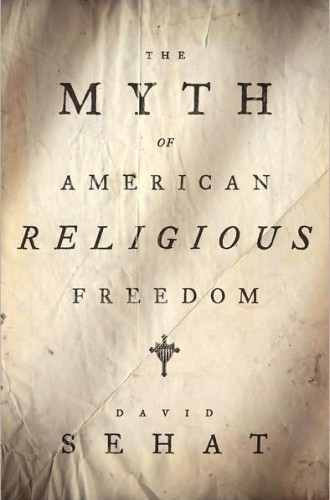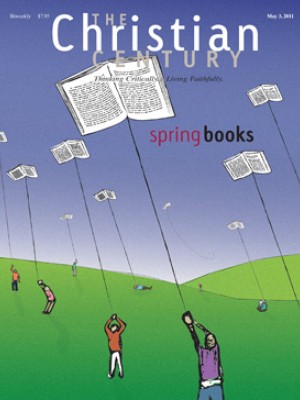The Myth of American Religious Freedom, by David Sehat
In 1859, an 11-year-old Catholic boy, Thomas Whall, refused to recite the Ten Commandments from the King James Bible in a public school. McLaurin Cooke, an assistant principal, whipped Whall's hands with a rattan rod for 30 minutes. With his hands bleeding and swollen, the boy finally gave in. Police arrested Cooke, but a court dismissed charges of assault and battery.
For David Sehat, the torture of Thomas Whall is an especially glaring example of a larger historical reality. In The Myth of American Religious Freedom, Sehat argues that the early American republic created a Protestant Christian "moral establishment" that not only persecuted Catholics, Jews and Mormons but also reified white supremacy, patriarchal authority and corporate control.
Read our latest issue or browse back issues.
The core argument in The Myth of American Religious Freedom is that for decades liberal justices and politicians have been fighting bad laws and precedents with bad history. In cases involving religion and public schools, for instance, justices have treated devotional exercises as aberrant violations of fundamental American principles. They have mistakenly suggested that Thomas Jefferson's interpretation of the Establishment Clause ("a wall of separation between church and state") reflected a consensus during the first 150 years of the American republic.
Instead, Sehat argues, Protestant Christians quickly brushed off the end of formal denominational establishments and imposed an interdenominational (but no less sectarian) moral order on American society. State legislatures passed laws against blasphemy, closed businesses on Sundays and tasked public schools with inculcating Christian virtue. Irrespective of statutory legislation, many jurists believed that the inherited common law included certain Christian precepts.
These Protestant establishmentarians did not always get their way. Congress did reject a broad-based evangelical attempt to end Sunday delivery of mail. Nevertheless, the moral establishment was strong enough to socially disadvantage non-Protestants and place them in legal jeopardy. Sunday-closing laws placed observant Jews at an economic disadvantage, Protestant devotional exercises drove Catholics out of public schools, and Congress targeted Mormons with antipolygamy legislation. Although blasphemy prosecutions largely ended by the mid-19th century, the possibility of prosecution under such laws continued to harass free thinkers for several more decades.
More subtly, proponents of the moral establishment viewed abolitionists, advocates for women's rights and labor activists as threats because of their emphasis on individual rights over social order. Thus, after the Civil War, most northern white Protestants quickly abandoned any support for black civil rights and accepted the need for southern segregation laws to protect white society from what they considered the base instincts of African Americans. Similarly, before the early 1900s most Protestant churches and most justices supported government repression of striking workers (most of them Catholic) to guard against social anarchy. In short, Sehat concludes, "the moral establishment was a religious establishment by proxy."
After 1940, liberal Supreme Court justices largely demolished the Protestant establishment by applying the First Amendment's religion clauses to state and local legislation and practices. The Court's new emphasis on individual liberties struck down prayer in public schools, discrimination against Jehovah's Witnesses, most restrictions on contraceptives and abortion, and—eventually—sodomy laws. An alliance of evangelicals and conservative Catholics continues to wage a campaign against this liberal jurisprudence, and Sehat worries that the Roberts Court will prove receptive to their arguments.
Sehat argues that both liberals and conservatives need to reckon more fully with the history of religious coercion in the United States. While conservative legal theorists and justices are correct when they argue that the United States has a long history of accommodating the role of Christianity within its laws and public institutions, they "have been hiding behind the myth of religious freedom" by ignoring past elements of religious coercion.
Liberals have trumpeted the same myth because they fear that conceding Christianity's history of past privilege would provide legal ammunition for their opponents. "In so doing," Sehat concludes, "they have given up the most compelling argument for their own jurisprudence, which was originally to liberate the individual from religious oppression that used the apparatus of the state." The moral establishment's ugly past of repression and discrimination, he further suggests, is far more instructive than endless parsing of the First Amendment itself. In order to satisfy a wide variety of perspectives on the relationship between church and state, the amendment's language was necessarily opaque.
While rejecting both religion and nationalism as vehicles for social consensus, Sehat too optimistically suggests—in agreement with some of the liberal justices he discusses—that a shared commitment to individual rights might provide a durable substitute. Often, however, courts—and legislatures—adjudicate between competing notions of individual rights. In 1964's Atlanta Motel v. United States, for instance, the Supreme Court held that the federal government could require hotels and restaurants to serve members of the public regardless of their race. While the Court cited the interstate commerce clause, it also observed that Congress had acted to correct what it saw as immoral behavior. Any reasonable standard of justice required truncating the rights of business owners to choose their clientele in order to uphold citizens' rights to access to public accommodations.
American politics and jurisprudence are replete with such clashes between competing notions of rights, and some of those clashes are morally much more ambiguous. Ultimately courts must choose some notions of morality over others, and all societies possess coercive forms of moral establishment, whether religious or secular. To suggest otherwise would only inaugurate another round of mythmaking about freedom.
Mostly, though, Sehat's argument is sobering and persuasive. Historical amnesia serves no one well in the long run. His evidence of past coercion should help conservative opponents of recent jurisprudence understand why liberals sometimes bristle over even minor ceremonial breaches in Thomas Jefferson's "wall of separation." At the same time, the fact that Protestant Christianity enjoyed the benefits of unofficial establishment explains why so many evangelicals pine for a return to "Christian America."
Americans from Supreme Court justices to activists to church members have argued for decades about the First Amendment's religion clauses. While Sehat sympathizes with advocates of a strict separation between religion and government, he does not engage specific church-state issues before the courts. Instead, he concludes with some basic questions that might help politicians, jurists and others rethink such matters. For example, what minimal moral standards do we expect of one another, and how do we maintain them while being fair to all? Although this book is unlikely resolve contemporary disagreements, at the very least Sehat has reminded his readers of the stakes inherent in these debates.






